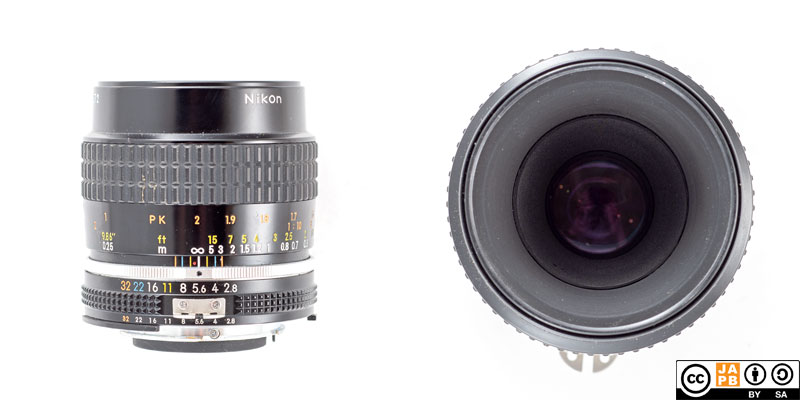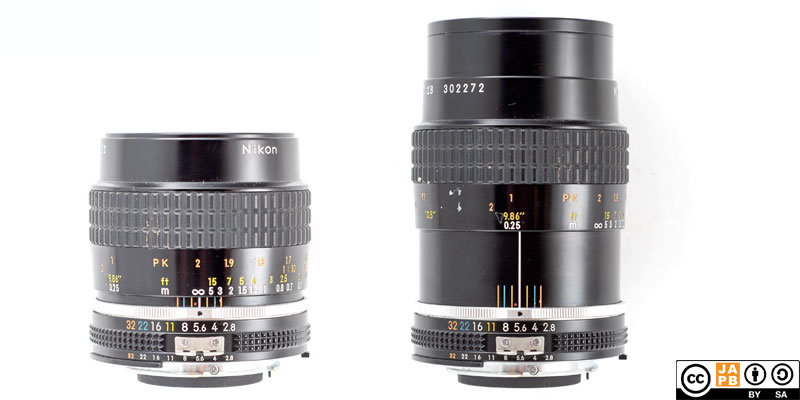Pekka Buttler, 09/2022 (updated 03/2023)

Specifications
The table below summarizes the lens’ key specifications (measurements based on pictured sample):
| Brand: | Micro-Nikkor | Lens name | 55 mm 1:2.8 |
| Focal length 1 | 55 mm | Angle-of-view 2 | 43 ° |
| Maximum Aperture | f/2.8 | In Production | 1979–2020 |
| Lens mount | Nikon F | Subfamily (if applicable) | Ai-s |
| Length 3 | 62,1 mm | Diameter 4 | 63,0 mm |
| Filter ring diameter | 52 mm | Weight | 290 grams |
| Lens element count | 6 | Lens group count | 5 |
| Aperture blades (S/R/C) 5 | 7 S | Focus throw | 310 ° |
| Minimum focusing distance | 25 cms | Maximum magnification | 1:1,9 |
| Has manual aperture ring | YES | Has Manual focus ring | YES |
| Aperture mechanism type | Automatic | Aperture click stops 6 | 2.8-4-5.6-8-11-16-22-32 |
Further notes:
• Nikon traditionally refers to its macro lenses with the term ‘micro‘.
• This lens is Nikon’s first f/2.8 short macro/micro lens.
• The lens uses Nikon’s Close Range Correction (CRC) to improve close-up IQ.
• It is not a ‘true macro’ lens in that it does not reach 1:1 maximum magnification without the dedicated PK-13 extension tube (when using that tube, the lens no longer reaches infinity).
• During the more the 40-year long production run Nikon manufactured more than half a million copies.
• The successor is the AF/AF-D 55 mm f/2.8 which is optically the same lens, but uses a different barrel design allowing that lens to reach 1:1 without an extension tube.
• The front lens is deeply recessed, hence using a lens hood is not likely to be needed. However, should one want to use a lens hood, Nikon recommends the steel HN-3 hood.

Right: Focused to MFD
A brief genealogy of Nikon SLR lens types
Nikon is undoubtedly one of the great names in 35 mm SLR photography. The Nikon F mount has been in continuous production since 1959. During that time, the mount has developed/changed in some detail, however without ever fully sacrificing compatibility.
In short (a longer version is here), the development of Nikon’s SLR lenses can be traced as follows:
• 1959–1977: Pre-Ai. Manual focus lenses that use ‘rabbit ears’ to communicate selected aperture with the camera body. Pre-Ai lenses can further be subdivided into
• F-type (1959–early 1970s: metal focus ring and single-coated),
• C-type (early 1970s–mid 1970s: metal focus ring and multicoated), and
• K-type (mid 1970s to 1977: rubber focus ring and multicoated).
A significant share of remaining Pre-Ai lenses have since been converted to Ai-spec (Ai’d)
• 1977–1986: Ai and Ai-s. Manual focus lenses that may have ‘rabbit ears’ for backward compatibility, but are designed to communicate selected aperture with the camera body through indentations in base of aperture control ring.
• 1986–today: AF and AF-D. Autofocus lenses that do not have a focusing motor within the lens, but rely on the focus motor within the camera. All AF and AF-D lenses are simultaneously Ai-s lenses (they are Ai-s lenses extended with AF) 7
• 1996–today AF-S and AF-P. Autofocus lenses that have an internal focusing motor and do not rely on the body having a focusing motor.
Development of the short Micro-Nikkor lens
Nikon has been producing Micro lenses since 1961 (before that the customary approach was to use lenses dedicated for use on a bellows). Nikon has further also divided its micro offering in three segments: short micro lenses (50-60 mm); medium micro lenses (105 mm); and long micro lenses (200 mm). Most early long micro lenses were branded ‘Medical’ and contained an integrated light source.
The genealogy of Nikon’s approach to short micro lenses can be summarised as follows:
• 1961–1963 (F-type) 5,5 cm f/3.5 Micro, 5 elements in 4 groups, 1:1 (660 ° focus throw)
• 1963–1968 (F-type) 55 mm f/3.5 Micro, 5 elements in 4 groups, 1:2 (metal focus ring)
• 1969–1973 (F-type) 55 mm f/3.5 Micro-P, 5 elements in 4 groups, 1:2 (rubber, diamond-pattern focus ring)
• 1973–1975 (C-type) 55 mm f/3.5 Micro-P•C, 5 elements in 4 groups, 1:2 (rubber, diamond-pattern focus ring)
• 1975–1977 (K-type) 55 mm f/3.5 Micro, 5 elements in 4 groups, 1:2 (rubber, normal focus ring)
• 1977–1979 (Ai) 55 mm f/3.5 Micro, 5 elements in 4 groups, 1:2 (rubber, normal focus ring)
• 1979–2020 (Ai-s) 55 mm f/2.8 Micro, 6 elements in 5 groups, 1:1,9 (rubber, normal focus ring) (this lens)
• 1986–1989 (AF) 55 mm f/2.8 Micro, 6 elements in 5 groups, 1:1 (rubber, normal focus ring)
• 1989–2008 (AF/AF-D) 60 mm f/2.8 Micro, 8 elements in 7 groups, 1:1 (rubber, normal focus ring) [data sheet]
• 2008–2020 (AF-S) 60 mm f/2.8 Micro, 12 elements in 9 groups, 1:1
• 2021-today (Z) MC 50 mm f/2.8, 10 elements in 7 groups, 1:1
Adapting
Besides adapting, this lens can be used natively on all current high-end Nikon dSLRs and several earlier medium-to-high-end older Nikon dSLRs 8. Likewise, if it still has its rabbit ears, it can be natively used on all Nikon F-mount film cameras ever produced (without the rabbit ears, it is limited to post 1977 bodies). When doing macro photography on a Film SLR, remain mindful of effective aperture.
Thanks to being a fully manual lens (manual aperture, manual focus), the lens can be adapted to all mirrorless cameras using a suitable dumb adapter (and such adapters are easy to find). Moreover, a large range of special adapters (helicoid adapters, tilt/shift adapters, speed boosters) for using Nikon F lenses on most mirrorless systems are available.
Using Nikon F lenses on non-Nikon SLRs and dSLRs is likewise a distinct possibility. Thanks to the relatively generous flange focal distance of the Nikon F mount (46,5 mm), adapter rings for all dSLR mounts are available as well as for a goodly portion of film-era SLR mounts. Such rings may not allow for auto aperture, but even then the lenses can be used in stop-down metering mode.
Footnotes
- Focal length is (unless stated otherwise) given in absolute terms, and not in Full-frame equivalent. For an understanding of whether the lens is wide/tele, see ‘Angle-of-view’. ↩︎
- Picture angle is given in degrees and concerns the diagonal picture angle. Rule of thumb:
> 90 ° ==> Ultra-wide-angle
70–90 ° ==> Wide-angle
50–70 ° ==> Moderate wide-angle
40–50 ° ==> ‘Standard’ or ‘normal’ lens
20–40 ° ==> Short tele lens
10-20 ° ==> Tele lens
5-10 ° ==> Long tele lens
< 5 ° ==> Ultra-tele lens ↩︎ - Length is given from the mount flange to the front of lens at infinity. ↩︎
- Diameter excludes protrusions such as rabbit ears or stop-down levers. ↩︎
- S=straight; R=rounded; C=(almost)circular at all apertures. ↩︎
- Numbers equal aperture values on aperture ring; • intermediate click; – no intermediate click. ↩︎
- There is a further sub-class of AF-D lenses called AF-I lenses that are otherwise AF-D lenses (meaning, fully Ai-s compatible), but have an internal focus motor. Only long tele lenses were made in AF-I variants. ↩︎
- As of this writing, the following Nikon dSLRs fully support Aperture priority and manual metered modes on Nikkor Ai lenses: D2, D3, D4, D5, D6, D200, D300, D300s, D500, D600, D610, D700, D750, D780, D800, D800E, D810, D850, D7000, D7100, D7200 ↩︎